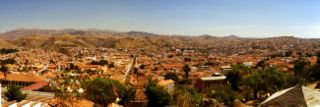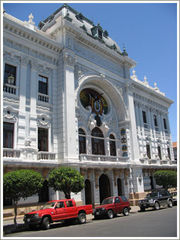Sucre
2007 Schools Wikipedia Selection. Related subjects: Central & South American Geography
Sucre (population 247,300 in 2006) is the constitutional capital of Bolivia, seat of the Supreme Court (Corte Suprema de Justicia), and capital of the Chuquisaca department. Located in the south-central part of the country, Sucre lies at an altitude of 2,800m (9,200ft). Historically the city has also been known as Charcas, La Plata and Chuquisaca, resulting in the nickname of "the City of Four Names" or "la Ciudad de Cuatro Nombres." As most of the colonial buildings in the city centre are whitewashed, the city also enjoys the nickname of "the white city" or "la ciudad blanca." Sucre is located at (-19.043056, +65.259167).
On November 30, 1538 Sucre was founded under the name Ciudad de la Plata de la Nueva Toledo by Pedro de Anzures, Marqués de Campo Redondo. In 1559 the Spanish King Philip II established the Audiencia de Charcas in La Plata with authority over an area which covers what is now Paraguay, southeastern Peru, Northern Chile and Argentina, and much of Bolivia. In 1601 the Recoleta Monastery was founded by the Franciscans and in 1609, an archbishopric was founded in the city. In 1624, San Francisco de Xavier University was founded.
Very much a Spanish city during the colonial era, the narrow streets of the city centre are organized in a grid, reflecting the Andalusian culture that is embodied in the architecture of the city's great houses and numerous convents and churches. Sucre remains the seat of the Catholic church in Bolivia, and a common sight is members of religious orders dressed in traditional garb.
Until the 18th century, La Plata was the judicial, religious and cultural center of the region. In 1839, after the city became the capital of Bolivia, it was renamed in honour of the revolutionary leader Antonio José de Sucre. Too remote after the economic decline of Potosí, it saw the Bolivian seat of government move to La Paz in 1898. In 1991, Sucre became a UNESCO World Heritage Site.
The city attracts thousands of tourists every year thanks to its well-conserved downtown with buildings from the 18th and 19th century. Nestled at the foot of the twin hills of Churuquella and Sika Sika, Sucre is the gateway to numerous small villages that date from the colonial era, the most well-known of which is Tarabuco, home of the colorful " Pujllay" festival held each March. In these outlying villages, one is as likely to find a descendant of the Spanish conquest as members of an indigenous group that still dress in their unique native clothing they use not only to preserve their cultural identity but also to let others instantly know what town or region they are from.


